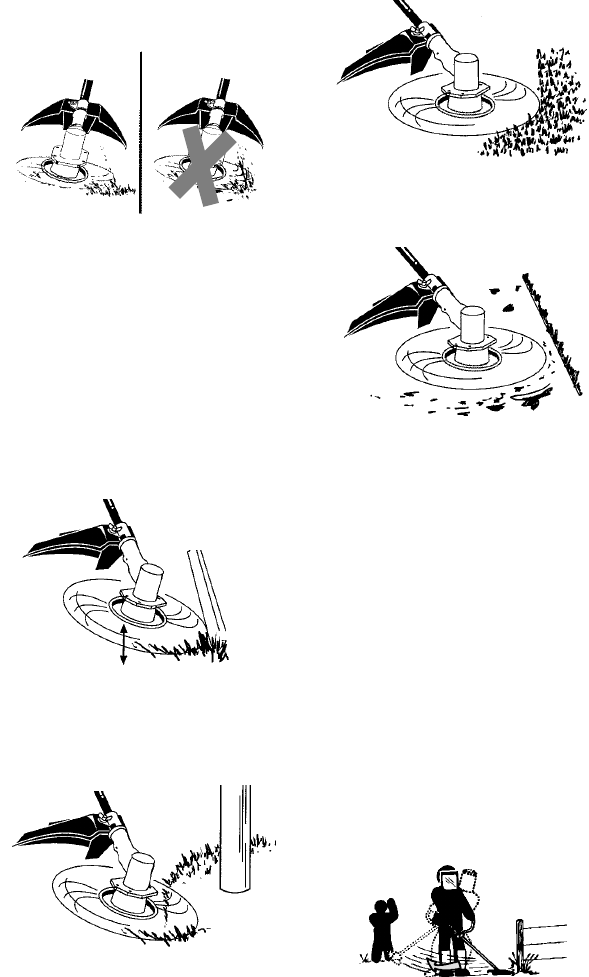
11
mum linewear by not crowding the line into
the cutting area. The right and wrong ways
are shown below.
Tip of the line
does the cutting.
Right Wrong
Line crowded into
work area.
S The line will easily remove grass and
weedsfromaround walls,fences,treesand
flower beds, but it also can cut the tender
bark of trees or shrubs and scar fences.
S For trimming or scalping, use less than full
throttle to increase line life and decrease
head wear, especially:
S During light duty cutting.
S Near objects around which the line can
wrap such as small posts, trees or fence
wire.
S Formowing orsweeping,usefull throttlefor
a good clean job.
TRIMMING -- Hold the bottom of the trimmer
head about 3 inches (8 cm) above the ground
and at an ang le. All ow only the tip of the line t o
make contact. Do not force trimmer line into
work area.
Trimming
3 inches (8 cm)
above ground
SCALPING -- The scalping technique removes
unwanted vegetation down to the ground. Hold
the bottom of the trimmer head about 3 inches
(8 cm) above the ground and at an angle. Allow
the tip of the line to strike the ground around
trees,posts,monuments, etc. This technique in-
creases line wear .
Scalping
MOWING -- Your trimmer is ideal for mowing
in places conventional lawn mowers cannot
reach. In the mowing position, keep the line
parallel to the ground. Avoid pressing the
head into the ground as this can scalp the
ground and damage the tool.
Mowing
SWEEPING -- Thefanning actionof therotat-
inglinecanbeusedto blowaway loosedebris
from an area. Keep the line parallel to and
above the area surface and swing the tool
from side to side.
Sweeping
OPERAT ING INSTRUCTIONS FOR
USE WITH WEED BLADE
S Bla d e Thrus t is a reaction that only occurs
when using a bladed unit. This reaction can
cause serious injury such as a mputation.
Carefully study this section. Itis importantthat
you understand what causes blade thrust,
how you can reduce the chance of its
occurring, and how you can remain in control
of unit if blade thrust occurs.
S WHAT CAUSE S BLADE THRUST -- Blade
Thrust can occur when the spinning blade
contacts an object that it does not cut. This
contact causes the bladeto stop foran instant
and then suddenly move or “thrust” away
from the object that was hit. The “thrusting”
reaction can be violent enough to cause the
operator t o be propelled in any d irection and
lose control of the unit. The uncontrolled unit
can cause serious injury if the blade contacts
the operator or others.
S WHEN BLADE THRUST OCCURS --
Blade Thrust can occur without warning if
the blade snags, stalls, or binds. This is
more likely to occur in areas where it is
difficult to see the material being cut. By
using the unit properly, the occurrence of
blade thrust will be reduced and the
operator will be less likely to lose control.
S Cutonlygrass,weeds,andwoody brushup
to 1/2inch (1 cm)in diameterwith theweed
blade. Do not let theblade contact material
it cannot cut such as stumps, rocks,


















